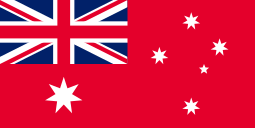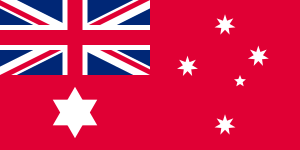Australian Red Ensign facts for kids
 |
|
| Use | Civil ensign |
|---|---|
| Proportion | 1:2 |
| Adopted | 11 February 1903 in use from 3 September 1901 23 February 1908 (current seven-pointed Commonwealth Star version) |
| Design | A Red Ensign with the Commonwealth/Federation Star at the hoist, and the Southern Cross in the fly half |
The Australian Red Ensign is a special flag for Australian ships. It's the flag that shows a ship is from Australia. This flag looks a lot like Australia's main blue national flag, but it's red! Both flags were chosen after a big competition in 1901. The competition asked for two flag designs: one for the government and one for merchant ships (ships that carry goods). The winning design for the merchant ship flag was based on an old British flag. It included the Southern Cross and the Commonwealth Star.
Contents
What the Flag Looks Like
The Australian Red Ensign is mostly red. The red color is the same as the red cross found on the Union Jack (the flag of the United Kingdom), which is in the top left corner of the Australian Red Ensign.
Flag for Ships
After Australia became a federation in 1901, new rules were made about flags for ships. The Navigation Act said that Australian civilian ships should fly the Australian Red Ensign. At first, smaller, non-registered boats were supposed to fly the British Red Ensign. But in 1938, a special rule allowed these smaller boats to fly the Australian Red Ensign too.
In 1981, Australia made its own shipping laws. These laws confirmed that the Australian Red Ensign was the correct flag for Australian registered ships. They also said that smaller boats, like pleasure boats or fishing boats, could fly either the Australian Red Ensign or the Australian National Flag, but not both at the same time.
History of the Flag
Designing the Flag
In 1901, the Commonwealth Government held a competition to design two new Australian flags. One flag was for official government use, and the other was for the merchant navy (ships that carry goods for trade).
The winning flag design had a Southern Cross with stars that had different numbers of points (nine, eight, seven, six, and five points). This was to show how bright each star looked in the night sky. Later, the British Navy changed the design. They made the four biggest stars of the Southern Cross have seven points each. This made the flags easier to make. In 1908, the Commonwealth Star also changed from six points to seven points, which is what we see today.
Early Use of the Red Ensign
For many years after Australia became a nation, the Red Ensign was the main flag used by regular people on land. This was because the government encouraged people to use the Red Ensign. The Australian Blue Ensign (which is now the Australian National Flag) was traditionally kept for official government buildings. Even during World War I and World War II, Australian soldiers sometimes served under both the blue and red flags. State governments, local councils, private groups, and individuals were all expected to use the Red Ensign.
In the 1920s, there was some discussion about which flag should be used. In 1924, it was agreed that the Union Flag (the UK flag) would be the main national flag. State and local governments were then allowed to use the Blue Ensign. A government note from 1939 said that "the Red Ensign is the flag to be flown by the public generally." It also said that the Blue Ensign was only for Commonwealth Government use.
In 1940, the government in Victoria allowed schools to buy Blue Ensigns. The next year, Prime Minister Robert Menzies suggested that the Blue Ensign should be flown at schools, government buildings, and by regular people. He also said that merchant ships should continue to use the Red Ensign. Prime Minister Ben Chifley said similar things in 1947.
Even with these statements, there was still some confusion. Finally, in 1953, the Flags Act 1953 was passed. This law officially made the Blue Ensign the Australian National Flag. The Australian Red Ensign then became known as the civil ensign, used mainly by ships.
Australian National Flag Day was officially announced in 1996.
Since 2008, September 3rd has also been celebrated as Merchant Navy Day. On this day, the Australian Red Ensign can be flown on land as a special honor. Merchant Navy Day remembers the important help that merchant ships and sailors gave during wartime, especially in the Pacific campaign in World War II.
Historical Red Ensigns
-
Red Ensign of South Australia (1870–1876)









